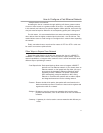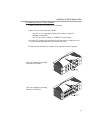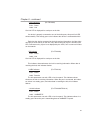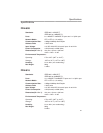
Cable Connections
Once the hub has been correctly mounted as explained before, cables linked to
end nodes can be connected to the ports.
Caution: While connecting cables to the hub, make sure both the hub and the
equipment being connected are turned off.
- Connecting end nodes with a cable : To connect a cable to an end node,
users must first shut off the end node's
power. If the end node is switched on
while connecting it to the hub, a loose
connection might result in opening an
internal contact inside the node, thus
damaging both the adapter and the end
node.
- Connecting a cable to the hub : To connect a cable to the hub, an RJ-45 jack
on the hubÕs rear panel should be selected.
Once the cable is being plugged into the end
node's adapter, it should be plugged into the
hub's selected jack.
The following cable requirements should be remembered before proceeding with
connections:
- Cables must be of a UTP-5 or STP-1 or equivalent cable type in order to be
used in a Fast Ethernet network. Such cables must feature RJ-45 plugs at
both ends, and straight-through wiring.
- In a Fast Ethernet network, cable lengths must not exceed 100 meters (328
feet) between network end nodes and the hub.
- All end nodes connected to a Dual-Speed Stackable Hub must be equipped
with Fast Ethernet adapters complying with the IEEE802.3u standard.
- Cables should be kept as far as possible from any electrical source, motor or
fluorescent light.
When uplinking two hubs together, users must make sure that the uplink ports
of both hubs are free, then one end of the uplink cable has to be plugged into the
18
Chapter 5 - continued


















